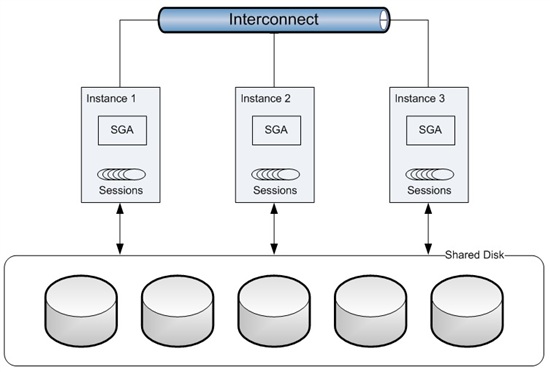Optimizing Oracle RAC
Oracle Real Application Clusters (RAC) databases form an increasing proportion of Oracle database systems. RAC was introduced in 2001 as part of Oracle 9i and was based on Oracle’s earlier Oracle Parallel Server architecture. RAC is almost unique as a mature implementation of a shared disk database clustering system: it is the basis for Oracle’s Exadata database machine, and allows for economical scalability and high availability.
All the usual principles of database performance tuning apply to RAC. However, the RAC architecture provides some additional challenges and opportunities.
The key principles in RAC performance management are:
- Maintaining high speed communications between the instances in the cluster.
- Eliminating unnecessary inter-instance traffic.
- Balancing workload between the instances in the cluster.
RAC architecture
RAC is a shared disk clustered databases: every instance in the cluster has equal access to the database’s data on disk. This is in contrast to the shared nothing architecture employed by other RDBMS clusters. In a shared nothing architecture, each instance is responsible for a certain subset of data. Whenever a session needs that data, then the appropriate instance must be involved in serving up the data.
Shared nothing database clusters have their advantages, but transparent and rapid scalability is not one of them. The shared nothing architecture requires that data be distributed across the instances in the cluster. When a new instance is added to the cluster, data needs to be redistributed across the cluster in order to maintain a reasonable balance of load. In contrast, a new instance can be added to a RAC cluster without any data rebalancing being required: the new instance has immediate and independent access to all the data in the database.
It is this ability to rapidly add or remove instances from RAC clusters that justifies the “G for Grid” in the Oracle 10g and 11g naming convention: RAC has the ability to rapidly scale database clusters by adding or removing instances: that capability is required (but perhaps not sufficient) to create a truly grid-enabled database.
The main challenge in the shared disk architecture is to establish a global memory cache across all the instances in the cluster: otherwise the clustered database becomes IO bound. Oracle establishes this shared cache via a high-speed private network referred to as the cluster interconnect.
All the instances in a RAC cluster share access to datafiles on shared disk, though each have private redo logs and undo segments. Each instance has its own SGA and background processes and each session that connects to the cluster database connects to a specific instance in the cluster.
Figure 1 RAC architecture
Global Cache Requests
Understanding how instances in the cluster communicate is critical to understanding RAC performance. As with single-instance Oracle, we want to avoid disk IO whenever possible
